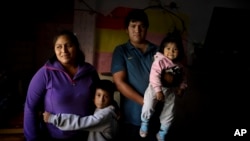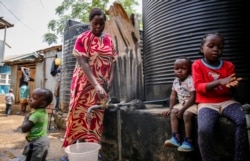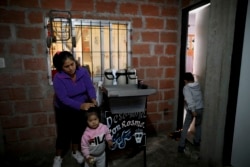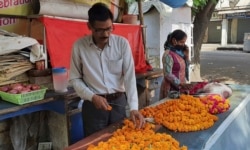From India to Argentina, millions of people who were already struggling have had their lives made harder during the new coronavirus pandemic.
The International Labor Organization, or ILO, says more than four out of five people in the world’s labor force of 3.3 billion have been affected by workplace restrictions. The organization added 1.6 billion temporary workers “stand in immediate danger of having their livelihoods destroyed.”
Their families now face hunger and poverty. However, they cannot stay at home and have to find a way to work for their next meal.
The Associated Press followed six people from different parts of the world to show how the pandemic has affected them.
Nairobi, Kenya
Judith Andeka is a 33-year-old mother of five. She lost her husband two years ago. She makes between $2.50 to $4 a day from washing clothes in Nairobi’s Kibera, one of the world’s poorest area.
People are not going to work during the pandemic, so they cannot pay for her services. Even if they could pay, they do not want her to touch their clothes because they are worried about the virus.
“I haven’t had a good day for the last two weeks,” Andeka said. She sent her five children to live with relatives. “I had no choice, because how do you tell a 2-year-old you have no food to give them,” she said.
At a food distribution place in Kibera, Andeka often faces men with sticks who beat back the large crowd and police who fire tear gas. Each time she goes out looking for food and work, she risks being robbed of her few belongings, including plastic chairs, a thin table, buckets for collecting water, a small gas burner and an old black-and-white TV.
“It’s better for corona(virus) to end and we continue living in hunger,” Andeka said. “Hunger is normal.”
Buenos Aires, Argentina
Rosemary Páez Carabajal sold coffee on the streets of Argentina’s capital, Buenos Aires, until the restrictions forced her to stop. Her husband is also out of work. They and their two children pay about $119 a month to live in a single room. The room is now filled with textbooks as they try to teach their seven-year-old son.
They are using up their savings, having received a one-time government aid payment worth about $150. For now, the supervisor of their building is not collecting rent.
Páez Carabajal worries her coffee business may not survive after restrictions are eased. “People are going to have doubts about buying because the disease is transmitted by grabbing things,” she said.
The coronavirus came during a recession in Argentina. More than one third of its 44 million people live in poverty. About 3 million people have requested food aid in recent weeks. That is in addition to the 8 million getting such assistance before the pandemic.
Jakarta, Indonesia
When Budi Santosa, a cook in a Chinese fast food restaurant, was told he would lose his job, he was not sure how to tell his wife.
“I am the breadwinner of the family. My children are toddlers. So they are the first things I thought about that day,” he said.
The 32-year-old is one of nearly 2 million people who have lost their jobs in Indonesia as a result of the pandemic. It is a country of 270 million people. Close to 10 percent live in poverty.
Not only has Santosa lost his job, the restrictions on movement mean he can no longer earn extra money as a taxi driver. “The government told us to stay at home, but if I stay home my wife and children will have no food to eat,” he said.
He now makes a little over $4 a day on average, down from $19 before the pandemic. That is just enough to buy food for himself, his wife and two young children. Santosa borrowed money from friends to pay April’s rent. He is not sure what he will do for the month of May.
Cairo, Egypt
The “ahwa,” or coffee shop, was among the first businesses ordered to close during the pandemic in Egypt. People were no longer permitted to smoke the “sheesha,” the water pipe so popular in the Middle East.
That cost Hany Hassan his job. He had been making $5 a day, just enough to feed his family. “We are financially ruined,” said the 40-year-old father of four.
Before the pandemic, one in three Egyptians or roughly 33 million people were living on about $1.45 per day. Some, about 6 percent, live on even less than a dollar a day. The government has since offered around $32 a month for those without work. Hassan is one of 2 million people who have applied.
“It’s not only me,” he said. “there are many people now who have nothing to feed their children.”
Amman, Jordan
Brothers Mohammed and Khalil Yousef used to work as truck drivers. Mohammed delivered building supplies. Khalil moved produce. Each earned between $14 and $28 a day. Between them they have nine children. All of the children are under the age of 16.
Mohammed said people living in Al-Wehdat, Jordan’s second-largest camp for Palestinian refugees, usually help each other out in hard times. But everyone is without work now. He opened his wallet showing identification cards, but no money. He said: “In the beginning I still had a little bit of money, but now there’s nothing.”
Some of the restrictions have been eased. The brothers are now partially getting back to work. There are fears, however, that loosening the restrictions could cause a rise of virus infections in overcrowded Al-Wehdat. But not having work worries people more. “People are afraid…of not being able to put food on the table,” Mohammed said.
Lucknow, India
Mahesh and Gita Verma sold flowers in a small store outside of a Hindu temple honoring the monkey god Hanuman. When officials ordered most businesses to close, they sold all their flowers for just a few cents.
India has the world’s largest population of extremely poor people. The World Bank estimates there are 176 million people living on less than $1.90 a day.
The Vermas have already struggled to feed their five children, ages eight through 20. Now they eat mostly potato-based dishes. They also have canceled their cable TV — a small pleasure that, to them, represented success.
“We cannot have food like we used to have,” Gita said.
The couple feared they would run out of money and food before the end of the restrictions on May 18. So they took a small loan from friends to start selling bread and milk in their store. It is the kind of business that the government permits to operate during the shutdown.
I’m John Russell.
And I'm Ashley Thompson.
Hai Do adapted this Associated Press story for VOA Learning English. Mario Ritter, Jr. was the editor.
________________________________________________________________
Words in This Story
pandemic –n. the fast spread of a disease across a wide geographical area
relative(s) –n. people who share the same ancestors
distribution –adj. related to giving out or spreading around
rent –n. a regular payment to be able to live in a place you do not own
grabbing –v. to take something quickly
toddler –n. a young child just learning to walk
temple –n. a building for worship















